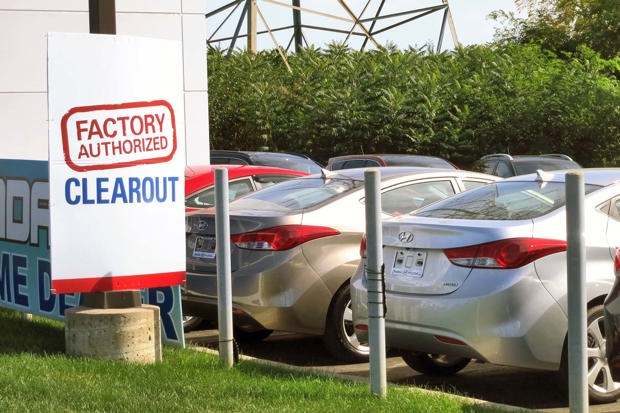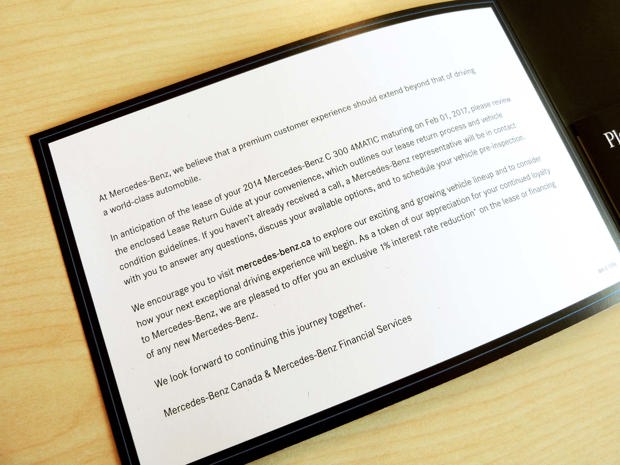There are always concerns with a used car: is it really as good as the seller says? If you’d rather not investigate a car’s roadworthiness yourself, one of your options is to look for CPO, or Certified Pre-Owned.
This is a used vehicle backed with an inspection, age and mileage limitations, and warranty. They’re offered by almost all new-vehicle manufacturers on used versions of their automobiles, but some dealers offer programs of their own.
So should you go with a factory or dealer program? There are pros and cons to each, and knowing them is the key to your best decision.
You never get something for nothing, and a CPO vehicle will cost more than a comparable used car – you’re paying for all the benefits that come with the plan. However, they often come with very favourable financing rates.
Part of the overall profit in a CPO depends on it not needing much in the way of warranty repairs, and the inspection standards weed out cars that will probably need them. No one wants to throw money at a sub-par car to make it pass, so certified vehicles are chosen from the cream of the off-leases and trade-ins coming into the store. They also have to be within a certain age and mileage for the warranty coverage.
Each manufacturer or dealer administers its own programs, so there will be differences between them. Here’s a general overview of what you can expect.
The Manufacturer’s CPO

You buy a CPO at an automaker’s authorized dealership, and as you’d expect, it has to be that manufacturer’s brand. If you like something else on the used-car lot, it may be available with the dealership’s certification, but not under the factory CPO program.
The vehicle has to pass an inspection as set out by the automaker, with repairs done as needed with factory-authorized parts. Appearance is included in the inspection, since these higher-priced vehicles have to look the part when they’re on the sales lot.
Many include an exchange program if you’re not happy with the car after you get it home. The trial period can vary considerably from as little as one day to as much as a month.
Any factory warranty still on the vehicle carries over, but you’ll be offered the option of buying extended warranty. Factory coverage is accepted at any authorized dealership, although, depending on the plan, you may have to pay a deductible.
The CPO package may include such perks as oil changes, roadside assistance, a rental if your vehicle is tied up for repairs, or a CarProof report, which outlines the vehicle’s history including any collision repair, liens, and outstanding recalls.
The Dealer’s Certification Program

Some dealers, including independent ones not affiliated with any automaker, offer their own certification programs. The vehicle will be inspected to a standard set by the dealer, and it will be within specified limits for age and mileage.
As with the factory CPO, any transferrable factory warranty will be included, and extended warranties will be offered. Any extra-charge coverage will generally be a third-party extended warranty.
Third-party coverage means you can get the vehicle repaired at most shops – you don’t have to go to your brand’s dealer – but none are required to accept the warranty at the counter. You may have to pay for the repairs yourself, and then file for reimbursement from the warranty provider. The plan may also require authorization before repair, and if it’s a major job, might even require that a warranty representative see the vehicle in person first.
Other perks will depend entirely on the dealer, including any exchange program, roadside assistance, or rental cars.
Looking at luxury or mainstream?

While you can get CPO vehicles at either end of the scale, their programs can have some differences – as can the cost benefit of buying a CPO vehicle.
Any used vehicle will save you the hit on depreciation, but luxury vehicles tend to take a heavier whack when they’re first driven off the lot. The luxury CPO will have a higher premium than a mainstream CPO, but if your heart’s set on high-end, what you’ve saved by buying used could offset the difference.
Some luxury manufacturers, including Audi, BMW, Lexus, Mercedes-Benz, and Porsche offer leases, as well as purchase, on CPO vehicles.
You might expect that a luxury CPO plan would give you more perks than a mainstream one, and in some cases they do, but read the fine print. Almost all include roadside assistance and favourable financing rates, and sometimes the “little guys” give you extra features – for example, Mazda gives you 30 days to exchange your vehicle if you don’t like it, while BMW gives you three.
What else do I need to consider?

Whether you choose a manufacturer or dealer CPO – or for that matter, whenever you buy any vehicle, new or used – it’s important to read and understand the fine print.
If you’re comparing brands by their warranty coverage, know what you’re getting. Each vehicle will likely still have some of its original factory powertrain or comprehensive warranty on it. But if it’s a five-year warranty, for example, does that mean five years from the day you buy it, or from its initial purchase date? If it’s the latter on a three-year-old car, your “five-year” warranty is really only two years.
And if you’re buying extended warranty, is it from the day you buy it, or from the day any existing warranty expires? If your five-year extended plan takes effect immediately, but the car still has two years of warranty left, you paid for five years but only needed three.

For any warranty, it’s just as important to know what’s not covered as what is. Find out if there’s a deductible and how much it is, and if it applies to each visit (no matter how many things are fixed at the time), or to each repair (if you get three repairs done during the same visit, you’ll pay three deductibles). If you have a choice, we recommend a factory-authorized warranty over an independent third-party one.
Find out if any warranty is transferrable, too – that can bring a premium if you decide to sell the vehicle privately later on.
If the car doesn’t come with a vehicle history, you might want to consider buying one to be sure there aren’t any surprises in its background.
And although the CPO process includes an inspection, the Automobile Protection Association (APA) says that “many automakers exercise poor oversight of their dealers,” and that it’s seen examples of cars with CPO certification that had defects. If you have any doubts, whether it’s CPO or dealer-certified, get an independent inspection done, or just walk away.
Consumer Reports agrees that sometimes the inspections aren’t as thorough as they could be. Depending on how much of a premium you’re paying for a CPO model, CR suggests you could be better off buying a regular used car and setting aside the difference to pay for any repairs in the future.

